The Immunologic Effect of Early Intravenous Two and Four Gram Bolus Dosing of Tranexamic Acid Compared to Placebo in Patients With Severe Traumatic Bleeding (TAMPITI): A Randomized, Double-Blind, Placebo-Controlled, Single-Center Trial
- PMID: 33013880
- PMCID: PMC7506112
- DOI: 10.3389/fimmu.2020.02085
The Immunologic Effect of Early Intravenous Two and Four Gram Bolus Dosing of Tranexamic Acid Compared to Placebo in Patients With Severe Traumatic Bleeding (TAMPITI): A Randomized, Double-Blind, Placebo-Controlled, Single-Center Trial
Abstract
Background: The hemostatic properties of tranexamic acid (TXA) are well described, but the immunological effects of TXA administration after traumatic injury have not been thoroughly examined. We hypothesized TXA would reduce monocyte activation in bleeding trauma patients with severe injury.
Methods: This was a single center, double-blinded, randomized controlled trial (RCT) comparing placebo to a 2 g or 4 g intravenous TXA bolus dose in trauma patients with severe injury. Fifty patients were randomized into each study group. The primary outcome was a reduction in monocyte activation as measured by human leukocyte antigen-DR isotype (HLA-DR) expression on monocytes 72 h after TXA administration. Secondary outcomes included kinetic assessment of immune and hemostatic phenotypes within the 72 h window post-TXA administration.
Results: The trial occurred between March 2016 and September 2017, when data collection ended. 149 patients were analyzed (placebo, n = 50; 2 g TXA, n = 49; 4 g TXA, n = 50). The fold change in HLA-DR expression on monocytes [reported as median (Q1-Q3)] from pre-TXA to 72 h post-TXA was similar between placebo [0.61 (0.51-0.82)], 2 g TXA [0.57 (0.47-0.75)], and 4 g TXA [0.57 (0.44-0.89)] study groups (p = 0.82). Neutrophil CD62L expression was reduced in the 4 g TXA group [fold change: 0.73 (0.63-0.97)] compared to the placebo group [0.97 (0.78-1.10)] at 24 h post-TXA (p = 0.034). The fold decrease in plasma IL-6 was significantly less in the 4 g TXA group [1.36 (0.87-2.42)] compared to the placebo group [0.46 (0.19-1.69)] at 72 h post-TXA (p = 0.028). There were no differences in frequencies of myeloid or lymphoid populations or in classical complement activation at any of the study time points.
Conclusion: In trauma patients with severe injury, 4 g intravenous bolus dosing of TXA has minimal immunomodulatory effects with respect to leukocyte phenotypes and circulating cytokine levels.
Clinical trial registration: www.ClinicalTrials.gov, identifier NCT02535949.
Keywords: hemostasis; immunology; monocyte activation; tranexamic acid; trauma.
Copyright © 2020 Spinella, Thomas, Turnbull, Fuchs, Bochicchio, Schuerer, Reese, Coleoglou Centeno, Horn, Baty, Shea, Meledeo, Pusateri, Levy, Cap and Bochicchio.
Figures


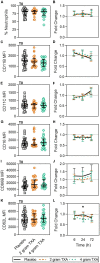
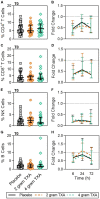
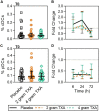

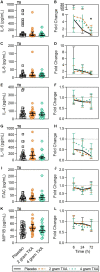
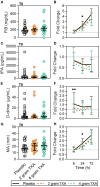
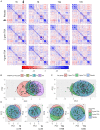
Similar articles
-
The risk of thromboembolic events with early intravenous 2- and 4-g bolus dosing of tranexamic acid compared to placebo in patients with severe traumatic bleeding: A secondary analysis of a randomized, double-blind, placebo-controlled, single-center trial.Transfusion. 2022 Aug;62 Suppl 1:S139-S150. doi: 10.1111/trf.16962. Epub 2022 Jun 29. Transfusion. 2022. PMID: 35765921 Clinical Trial.
-
A multi-center, double-blind, placebo-controlled, randomized, parallel-group, non-inferiority study to compare the efficacy of goal-directed tranexamic acid administration based on viscoelastic test versus preemptive tranexamic acid administration on postoperative bleeding in cardiovascular surgery (GDT trial).Trials. 2024 Sep 27;25(1):623. doi: 10.1186/s13063-024-08467-1. Trials. 2024. PMID: 39334224 Free PMC article.
-
Effect of Out-of-Hospital Tranexamic Acid vs Placebo on 6-Month Functional Neurologic Outcomes in Patients With Moderate or Severe Traumatic Brain Injury.JAMA. 2020 Sep 8;324(10):961-974. doi: 10.1001/jama.2020.8958. JAMA. 2020. PMID: 32897344 Free PMC article. Clinical Trial.
-
Tranexamic acid for trauma patients: a critical review of the literature.J Trauma. 2011 Jul;71(1 Suppl):S9-14. doi: 10.1097/TA.0b013e31822114af. J Trauma. 2011. PMID: 21795884 Review.
-
Efficacy of prehospital administration of tranexamic acid in trauma patients: A meta-analysis of the randomized controlled trials.Am J Emerg Med. 2018 Jun;36(6):1079-1087. doi: 10.1016/j.ajem.2018.03.033. Epub 2018 Mar 16. Am J Emerg Med. 2018. PMID: 29573898
Cited by
-
Prehospital tranexamic acid in trauma patients: a systematic review and meta-analysis of randomized controlled trials.Front Med (Lausanne). 2023 Oct 20;10:1284016. doi: 10.3389/fmed.2023.1284016. eCollection 2023. Front Med (Lausanne). 2023. PMID: 37928456 Free PMC article.
-
Dose-Dependent Tranexamic Acid Blunting of Penumbral Leukocyte Mobilization and Blood-Brain Barrier Permeability Following Traumatic Brain Injury: An In Vivo Murine Study.Neurocrit Care. 2024 Oct;41(2):469-478. doi: 10.1007/s12028-024-01952-0. Epub 2024 Mar 5. Neurocrit Care. 2024. PMID: 38443709
-
Tranexamic acid for major trauma patients in Ireland.World J Emerg Med. 2022;13(1):11-17. doi: 10.5847/wjem.j.1920-8642.2022.003. World J Emerg Med. 2022. PMID: 35003409 Free PMC article.
-
Blood failure: traumatic hemorrhage and the interconnections between oxygen debt, endotheliopathy, and coagulopathy.Clin Exp Emerg Med. 2024 Mar;11(1):9-21. doi: 10.15441/ceem.23.127. Epub 2024 Mar 21. Clin Exp Emerg Med. 2024. PMID: 38018069 Free PMC article.
-
Heterogeneity in defining multiple trauma: a systematic review of randomized controlled trials.Crit Care. 2023 Sep 22;27(1):363. doi: 10.1186/s13054-023-04637-w. Crit Care. 2023. PMID: 37736733 Free PMC article.
References
Publication types
MeSH terms
Substances
Associated data
Grants and funding
LinkOut - more resources
Full Text Sources
Medical
Research Materials
Miscellaneous

